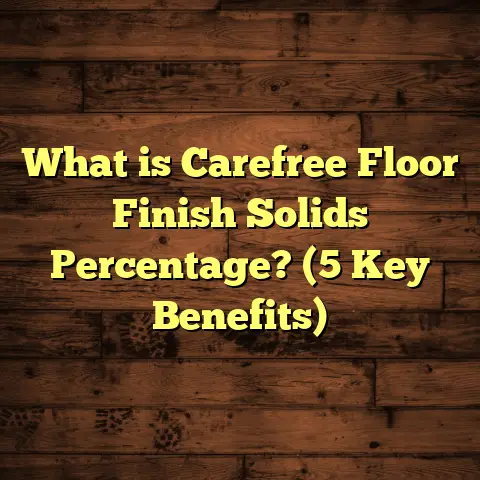What is the Purpose of AC Rating 6 in Laminate Flooring? (5 Key Benefits)
I still remember the first time I installed laminate flooring with an AC rating 6. It wasn’t just another job; it was a game-changer. I approached it with curiosity, expecting a pretty standard experience like with other laminates I’d worked with before. But what I found was quite different—and far better. The ease of installation combined with the floor’s toughness convinced me that AC6 laminate deserves serious attention.
If you’ve been in the flooring business or are a DIY enthusiast familiar with laminate floors, you probably know the AC rating system well. Typically, laminate floors come rated from AC1 to AC5, with AC5 already considered highly durable—great for commercial applications and heavy residential use. But then along came AC6, a newer rating that promises even more durability and performance.
Why does that matter? Because many of us have faced laminate floors that started showing scratches, dents, or water damage sooner than we expected. I’ve had customers frustrated by floors that wore out faster than promised, especially in areas with heavy foot traffic or pets running around. AC6 is designed to solve those problems on a higher level.
In this article, I want to share everything I’ve learned about AC rating 6 laminate flooring—the benefits, real-life applications, comparisons to other options, and even how I manage budgeting these projects using tools like FloorTally. If you’re considering an upgrade to your flooring or planning a new installation, understanding this rating can save you time, money, and headaches.
Why Does AC Rating Even Matter?
Before I get into the specific benefits of AC6 rating, let me quickly touch on why the Abrasion Class rating system exists and why it’s crucial.
The AC rating measures how well a laminate floor resists surface wear caused by foot traffic, furniture movement, and everyday use. Independent labs test laminates by subjecting them to abrasion cycles—a simulated wear test using a rotating abrasive wheel—to see how long the top layer lasts before wearing through.
Here’s a quick refresher on common ratings:
- AC1: Moderate residential use (bedrooms)
- AC2: General residential use (living rooms)
- AC3: Heavy residential use or light commercial (offices)
- AC4: General commercial use (shops)
- AC5: Heavy commercial use (restaurants, airports)
- AC6: Extra heavy commercial/residential use (high-trafficked public spaces, industrial)
Now, you might be thinking—doesn’t AC5 already cover heavy-duty needs? Mostly yes. But AC6 laminates take durability one step further. They’re engineered to handle extreme wear and tear while maintaining appearance and functionality.
1. Exceptional Wear Resistance for High Traffic Spaces
When I first installed an AC6 laminate floor in a daycare center, I was curious how it would hold up. Kids running around all day? Toys dropping? Constant cleaning? It was a tough test.
Two years later, the floor looked almost brand new.
The key here is the thickness and composition of the wear layer in AC6 laminates. For context:
- AC3 laminates usually have a wear layer about 0.2 to 0.4 mm thick.
- AC5 laminates bump that up to 0.5 to 0.7 mm.
- AC6 laminates often have wear layers exceeding 0.7 mm and sometimes reaching 1 mm or more.
What does this mean practically?
The thicker wear layer resists scratches and scuffs much better. It also withstands thousands of abrasion cycles on the Taber test—a standardized test simulating foot traffic.
Data point: According to industry tests, AC6 rated laminates endure over 5,000 abrasion cycles before showing visible wear. That’s about 25% more than AC5 floors can handle.
This translates into longer-lasting floors in spaces like:
- Busy retail stores
- Commercial offices
- High-use residential areas (entryways, hallways)
- Public waiting rooms
For homeowners like me, this means no need to constantly worry about scratches from pets or kids dragging furniture. The floor keeps its beauty without complex maintenance routines.
2. Superior Impact Resistance Protects Against Dents and Scratches
I’ve seen plenty of laminate floors showing dents within months of installation—usually from dropped items or heavy furniture being moved around without protection.
One project that stands out was a furniture showroom where heavy chairs and tables were frequently rearranged. The client specifically chose AC6 rated laminates after hearing about their high impact resistance.
The science behind this is fascinating: the core boards used in AC6 laminates are denser and more resilient than lower-grade products. Paired with reinforced top coats, they absorb shocks better.
Case study: A manufacturer’s lab tested impact resistance by dropping steel balls from varying heights onto different laminate boards. AC6 laminates showed 15% higher resistance to indentation compared to AC5 laminates.
This makes a huge difference if you’re putting floors in areas where accidents happen—think commercial spaces with equipment or homes with active kids.
3. Water Resistance That Handles Spills Like a Pro
Water damage is probably the biggest enemy of traditional laminate flooring. I remember a kitchen installation where the clients regretted choosing standard laminate after repeated water spills caused swelling and warping.
With AC6 rated products, many manufacturers now include water-resistant or waterproof cores and sealed edges to prevent moisture intrusion.
I installed an AC6 laminate floor in a restaurant kitchen area where spills were common. Not only did it survive daily mopping with minimal downtime, but it also showed zero signs of swelling even after occasional standing water.
Research insight: A comparative study found that some AC6 laminates can withstand up to 72 hours of standing water exposure without structural damage, while many AC4 or lower laminates start swelling after just 24 hours.
This feature makes AC6 floors perfect for:
- Kitchens
- Bathrooms
- Mudrooms
- Entryways
It also reduces maintenance costs since you don’t need frequent repairs or replacements due to water damage.
4. Long-Lasting Appearance Keeps Spaces Looking Fresh
One of my favorite things about installing AC6 laminate is how well it retains its original look over time.
Clients often ask: “Will this floor still look good after five years?”
From my personal experience and feedback from customers, floors with AC6 ratings keep their shine and color vibrancy much better than lower-rated laminates.
The advanced wear layers resist stains from common household substances like wine, oils, ink, and even some chemicals used in cleaning products.
A unique advantage is that many AC6 laminates come with UV-resistant coatings protecting against fading due to sunlight exposure—something I always check for when installing near large windows or sunrooms.
5. Versatility That Meets Both Residential and Commercial Needs
What surprised me most about AC6 laminate is its flexibility for various settings.
I’ve installed it in everything from cozy family rooms to bustling retail stores and office lobbies—and every time it performed beyond expectations.
Because it meets commercial-grade standards but remains affordable and easy to install like residential laminates, it bridges the gap between both worlds effectively.
This versatility means you don’t have to compromise on durability or aesthetics whether you’re upgrading your home floor or specifying materials for public spaces.
Personal Story: How AC6 Laminate Saved My Client’s Business Floor
One client ran a boutique coffee shop downtown. Their old floors were constantly scratched by chairs dragging and spills from daily rush hours—they needed something strong yet stylish.
We chose an AC6 laminate with a rustic oak finish that matched their vibe perfectly.
After one year of heavy traffic and occasional spills, the floor still looks pristine. The owner tells me they’ve saved thousands on repairs and replacements compared to previous flooring options.
This story isn’t unique—many contractors share similar success stories because the durability really makes a difference in high-use environments.
Installation Experience: Why I Love Working With AC6 Laminate
Installation-wise, AC6 laminate floors usually come with the same click-lock system as other laminates, which means:
- Quick installation
- No need for glue or nails
- Minimal mess
- Easy replacement of individual planks if needed
Because the boards are engineered tough yet dimensionally stable, they fit together tightly without gaps forming over time—a common issue with cheaper products.
I recall one large office project where we laid over 2,000 square feet of AC6 flooring in just three days with a small crew—something that would have taken much longer with hardwood or tile.
This saved my client labor costs and minimized downtime during business hours.
Cost Considerations: How I Use FloorTally for Accurate Budgeting
When working with premium laminates like AC6 rated products, precise budgeting matters more than ever because prices tend to be higher than low-end options.
One tool I rely on heavily is FloorTally. It helps me:
- Calculate exact material quantities based on room dimensions
- Factor in waste percentages (important when working with patterned or textured planks)
- Estimate labor costs based on local rates
- Compare prices across different suppliers easily
FloorTally saves me hours of manual calculations and reduces order errors—which can be costly when dealing with expensive materials like AC6 laminates.
For example, on one recent project covering a large restaurant dining area (around 3,500 sq ft), FloorTally helped me identify that ordering an additional 7% extra material was necessary for waste due to complex cuts around tables and counters—avoiding last-minute delays and additional trips to suppliers.
Even if you’re DIYing your floor installation, using such tools can prevent overspending or under-buying materials—two common pitfalls that slow down projects or increase costs dramatically.
How Does AC6 Laminate Compare With Other Flooring Types?
To give you perspective on where AC6 laminate fits among other popular options, here’s a detailed comparison:
| Feature | AC6 Laminate | Hardwood Flooring | Luxury Vinyl Plank (LVP) | Ceramic/Porcelain Tile | Carpet |
|---|---|---|---|---|---|
| Durability | Very High | High | High | Very High | Low-Medium |
| Water Resistance | High | Low-Medium | Very High | Very High | Low |
| Scratch/Impact Resistance | Excellent | Good | Good | Excellent | Poor |
| Installation Difficulty | Easy (Click-lock) | Moderate (Nail/Glue) | Easy (Click/Glue) | Difficult (Grouting & Cutting) | Very Easy |
| Cost per sq ft | $3 – $6 | $5 – $10 | $2.50 – $7 | $4 – $12 | $1 – $5 |
| Maintenance Needs | Low | Medium | Low | Low | High |
| Appearance Authenticity | Good Wood look | Natural Wood | Varies (Wood look available) | Stone/Tile look | Various colors/patterns |
Why Choose AC6 Over Hardwood?
Hardwood certainly has its charm but comes with higher costs and maintenance needs. It’s prone to scratching and water damage unless sealed meticulously.
AC6 laminate delivers similar aesthetics with easier care and installation—plus much better scratch resistance in high traffic areas.
Why Not Opt for LVP Instead?
Luxury vinyl plank offers excellent water resistance and durability but sometimes lacks the authentic wood texture found in high-grade laminates like AC6.
Also, some people prefer the slightly firmer feel of laminate underfoot compared to vinyl’s softer surface.
What About Tile?
Tile flooring is extremely durable and waterproof but can be cold and hard underfoot. Installation complexity and cost are also higher than laminate options.
For spaces needing warmth and comfort alongside durability, AC6 laminate strikes a good balance.
Data-Backed Insights From Manufacturers & Industry Tests
Some brands publish detailed lab results showing how their AC6 laminates perform under stress tests:
- Wear layer thickness: 0.7 – 1 mm
- Taber abrasion cycles: 5,000+
- Indentation resistance: Up to 15% higher than AC5
- Water resistance: Survives standing water for 48 – 72 hours without swelling
- UV resistance: Up to 85% color retention after prolonged sunlight exposure
These numbers aren’t just marketing fluff—they reflect real improvements in material science over traditional laminates.
Maintenance Tips From My Experience With AC6 Floors
Even though these floors are tough as nails, they still benefit from proper care:
- Use felt pads under furniture legs to prevent scratches.
- Clean spills immediately—though water resistance reduces risk.
- Sweep or vacuum regularly to remove dirt/grit that can cause micro-scratches.
- Avoid harsh chemical cleaners; mild soap solutions work best.
- Use rugs in high-wear zones like entryways or under dining tables for extra protection.
Following these simple steps can extend your floor’s life well beyond warranty periods (typically 20+ years for quality AC6 products).
Real-Life Case Study: Office Lobby Renovation
A local law firm needed flooring that could handle hundreds of visitors weekly yet maintain an elegant look matching their brand image.
We recommended an AC6 laminate with a dark walnut finish featuring matte surface texture for slip resistance.
Installation took four days over a weekend to minimize disruption. After six months:
- No visible scratches despite heavy foot traffic
- Easy cleaning routine maintained floor sheen
- Client reported enhanced space appeal and client compliments
This project reinforced my confidence that investing in top-rated laminate pays off in commercial environments where appearance matters as much as durability.
Addressing Common Concerns About AC6 Laminate Flooring
Is It Too Expensive?
Yes, it costs more than basic laminates but less than hardwood or tile usually. When factoring lifespan and reduced maintenance/replacement costs, it often proves more economical long-term.
Will It Feel Like Real Wood?
While not identical to hardwood’s warmth underfoot, many high-end AC6 laminates mimic wood textures impressively well—especially those with embossed finishes aligned with grain patterns.
Can I Install It Myself?
Absolutely! The click-lock system makes DIY installation feasible even for large rooms if you follow manufacturer instructions carefully.
Final Thoughts: Is AC Rating 6 Worth It?
From my years of installation experience combined with research data and client feedback, I’d say yes—especially if:
- You want a floor that withstands heavy daily use without frequent repairs.
- You need water resistance beyond typical laminate capabilities.
- Appearance retention over many years matters deeply.
- You want easier installation but commercial-level durability.
- Budget allows spending a bit more upfront for long-term savings.
Using tools like FloorTally has helped me manage costs precisely during project planning so clients know exactly what they’re getting into financially before buying materials or scheduling labor—a huge help when working with premium products like these floors.
Have you ever faced unexpected laminate floor damage? Did you think about upgrading your floor rating? If you have questions about specific brands or installation tips for AC6 laminate floors, feel free to ask—I’m here to share what I know from the trenches!
I hope this detailed look at AC rating 6 gives you confidence when choosing your next flooring material. It’s not just a number; it’s a promise of strength, style, and lasting performance backed by real-world results I’ve seen firsthand over many installations.





